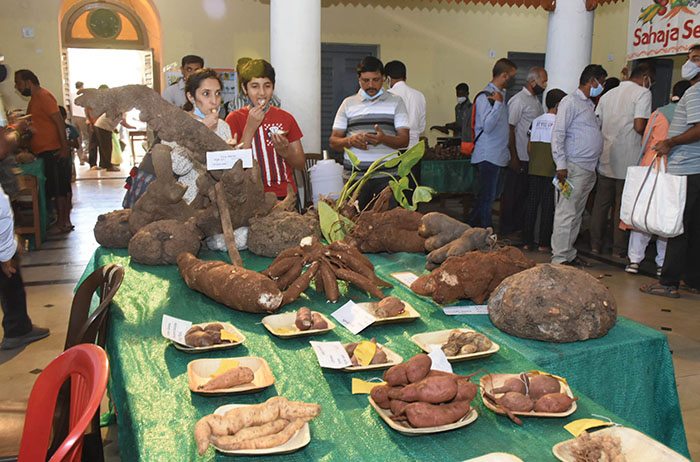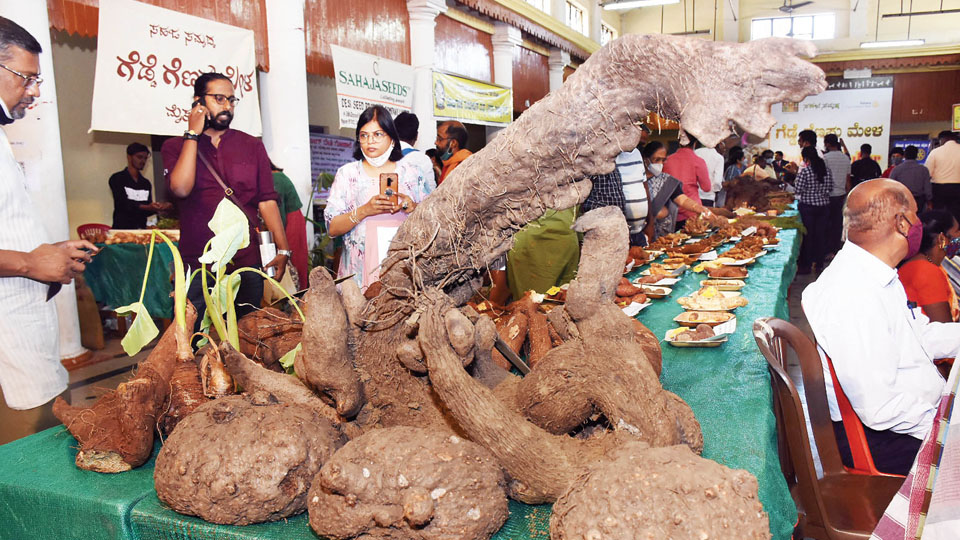Mysore/Mysuru: Tubers and roots that are a host of economical sources of dietary energy are on display at the two-day Roots & Tuber Mela that began at Nanjaraja Bahadur Choultry on Vinoba Road in city this morning. The Mela reconnected the community with roots and brought forgotten food back to plate.
The Mela has been organised by Sahaja Samrudha in collaboration with Rotary Club of Mysore (West) and its focus is to sensitise the urban community towards the benefits of tuber consumption and explore more value addition and include them into cultivation.
The Mela was inaugurated by Prof. G. Hemantha Kumar, Vice-Chancellor, University of Mysore, in the presence of Dr. Vishnuvardhan, Dean of Horticulture College, Mysuru, Reji Joseph, researcher and cultivator of a wide variety of tubers from Kerala, Dr. H.C. Amara Nanjundeshwara, Head of Horticulture Research and Extension Centre, Hassan, Dr. B. Chandra, President of Rotary West, Dr. Mohan Krishna, Secretary of Rotary West and G. Krishna Prasad of Sahaja Samrudha.
The Mela received good response from people who were crowding stalls asking questions about tubers, nutritional value and also the time they took to grow to that size.

A roots and tubers cooking contest has been organised on Feb. 13 where participants can prepare nutritious dishes at home and bring to Mela. Different sections showcase varieties of tubers and roots most of which look alike but have different nutritional elements. Elephant foot yam, fresho yam, lesser yam, nagara kona, mooli genasu to name a few are on display. They are as exotic as their shape and size. Some of the attractions at the Mela are giant sized greater yam (huttari genasu) that has been brought by Thimmaiah of Chowdikatte in Hunsur, different potato and sweet potato varieties by Horticultural Research and Extension Centre, Hassan.
Over 60 different tubers have been brought by Supreet of Adakuru village of Periyapatna taluk, purple yam by Jenu Kuruba women groups of Nagarahole forests, air potatoes from Mayasandra village and varieties of black, green and yellow turmeric and mango ginger.
N.M. Shaji of Kedaram Tuber Conservation at Wayanad is displaying 120 varieties of tubers including rare varieties collected from the Andaman Islands.

Roots and tubers are the underground secret treasures of nature which have many vitamins and minerals. They are low in calories and high in antioxidants. The crops include potatoes, taro, cassava, sweet potatoes and yams. Only second to cereals, they favourably adapt to diverse soil and environmental conditions and a variety of farming systems.
The energy from tubers is about one-third of that of an equivalent weight of rice or wheat due to the high moisture content of tubers. Tubers play a significant role in food security, nutrition and climate change adaptation. Many local communities preserve various varieties even to this day. They display a remarkable knowledge of the edible tubers that they gather or grow on the farms.
At the Mela, Betta Kuruba, Soliga, Irula and Kunbi tribes are displaying their tuber collection and more than 25 groups have brought different kinds of tubers, food items and value-added products. Rare roots and tubers, like air potato, purple yam, black turmeric and arrowroot seed material, are also available.








Recent Comments